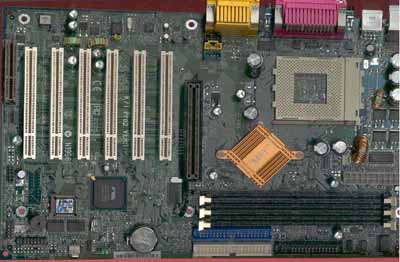
Original Link: https://www.anandtech.com/show/636
Microstar K7T Pro2 KT133 Socket-A ATX
by Henry Kuo on October 16, 2000 12:00 PM EST- Posted in
- Motherboards
Introduction
If you compare the rate companies push out new products now to that of a year ago, you will be amazed at how much faster it is now. In the processor market, Intel and AMD release faster chips nearly every month, and in the video card market, NVIDIA has stuck to a 6-month product cycle to make sure they have the fastest video card.
With processors and video cards improving every day, it is not too surprising to see that the motherboard market has also sped up their product cycles. Motherboard manufacturers face all kinds of challenges in supplying new products at a faster pace, and only a few manufacturers can keep up with that. Among them is Microstar, who seemingly never stops and is constantly releasing new products.
Regular AnandTech visitors will remember the K7T Pro KT133 motherboard we reviewed in June, which is one of the most stable KT133 motherboards we have worked with and currently powers 4 of AnandTech’s servers. In September, Microstar released the K7T Master, is the first Socket-A motherboard with integrated SCSI, targeting it at the high performance server / workstation market.
With all this success, Microstar could have relaxed a bit, but instead they have chosen to take another step forward by releasing yet another new Socket-A motherboard. This time it is not a whole new design, but a revision of the K7T Pro. They called it the K7T Pro2.
With so many competitors and so many KT133 solutions out there already, what can Microstar bring us this time with the K7T Pro2? And most importantly, can they still maintain the high quality and stability as they did with the previous motherboards?
|
Microstar K7T Pro2 |
|
|
CPU
Interface
|
Socket-A
|
|
Chipset
|
VIA
KT133
|
|
Form
Factor
|
ATX
|
|
Bus
Speeds
|
100
- 166MHz (1MHz increments)
|
|
Voltages
Supported
|
Auto Detect/1.500v - 1.850v (0.025v increments)
|
|
Memory
Slots
|
3
168-pin DIMM Slots
|
|
Expansion
Slots
|
1
AGP Slot |
|
On-board
Audio
|
VIA
VT1611A AC97 CODEC
|
|
BIOS
|
Award
Modular BIOS 6.00PGN
|
The Good
When you take a look at the K7T Pro2, you will notice that it looks an awful lot like the old K7T Pro. For starters, the the VIA 8363 North Bridge is rotated 45 degrees with respect to the edges of the motherboard. Microstar claims this layout results in shorter traces, and thus cleaner signals, to the AGP slot and CPU socket. Between the K7T Pro and the K7T Pro2, the only noticeable difference is the addition of a golden heat sink on the North Bridge, where it is green in color on the K7T Pro. Obviously this is not the main difference between the two boards since it would not justify an entirely new product from MSI.
The K7T Pro2’s real surprise comes when you enter the BIOS’s Frequency / Voltage Controls panel. The last setting reads “CPU CLK ratio.” Yes, you guessed it; this is the multiplier setting that can change the multiplier ratio of AMD Thunderbird and Duron processors! The available settings are 8 / 8.5 / 9 / 9.5 / 10 / 10.5 / 11 / 11.5 / 12 / 12.5. That means if you use the default 100MHz FSB and with enough cooling, theoretically you can run any AMD processors at 1.25GHz (100MHz x 12.5)! Sure this is not practical since most processors cannot handle the heat, but everyone knows that changing the multiplier for AMD processors is a much better way to overclock the CPUs than by just increasing the FSB.
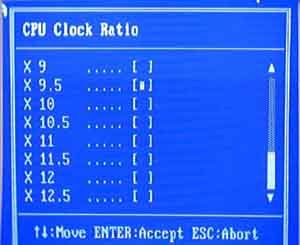
Multiplier overclocking is by far the easiest way to overclock your AMD Duron or Athlon for a few simple reasons. Most important is the fact that the KT133 chipset is currently unable to run the FSB above 110MHz while maintaining stability in the vast majority of cases. Unfortunately, most AMD processors that are currently available are “multiplier locked”, meaning that users are not able to change the multiplier easily. We put that in quotes because “unlocking” these CPU’s is as simple as reconnecting the L1 bridges on the processor. If you are interested in knowing how to unlock AMD processors and overclocking, please refer to our “AMD Thunderbird & Duron Overclocking Revealed” article.
Before the release of the K7T Pro2, the ASUS A7V, ABIT KT7-RAID, and the QDI KinetiZ 7T were the only three motherboards that allowed changing the multiplier of the processor. Not surprisingly, the ABIT and ASUS boards are two of the most popular boards among overclockers and we knew it would not be long before other motherboards manufacturers began releasing motherboards with multiplier settings. It is clear that the K7T Pro2 targets all those hardware enthusiasts, who want to have a motherboard that can push their AMD processors to the limit.
The K7T Pro2 is better than the ASUS A7V since the multiplier settings are all in BIOS like the ABIT KT7, so users will not have to play with any jumpers or dipswitches. Moreover, under the Frequency / Voltage Control panel you can also find the “Clock by Slight Adjustment” settings, where users can set the FSB anywhere between 100MHz and 166MHz in 1MHz increments. This can definitely help you squeeze out the last bit of performance from your processor if you are so inclined. As noted above, settings above 110 MHz are not particularly useful due to limitations of the KT133 chipset.
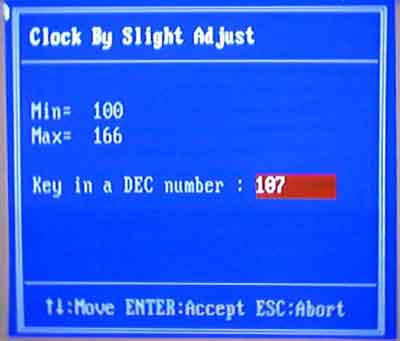
Microstar must have listened to all hardware enthusiasts about what they really want and need. Besides the FSB and multiplier settings, you can also adjust the CPU core voltage between 1.500 – 1.850Volts in 0.025Volts increments. This is absolutely a must for users who want to reach a CPU’s true limits. Microstar has also gone an extra mile and included a setting to change the I/O voltages of the motherboard between 3.3Volts and 3.45Volts. We have yet to see evidence that increasing I/O voltages helps, but it might come in handy later. Moreover, under the PC Health panel, users can find the temperatures of the CPU and the system, as well as the CPU fan and system fan speeds. It states the CPU core voltages, but it lacks information on the AGP voltages.
In order to illustrate how adjusting the multiplier can yield better overclocking, we performed a comparison between the K7T Pro and K7T Pro2. We use exactly the same set up, an AMD Thunderbird 800MHz OEM with a standard HSF, where the processor has its multiplier unlocked already. For the K7T Prothe highest FSB we got was just a merely 105MHz. Settings higher than that caused the system to become highly unstable. That makes the clock speed of the processor 840MHz (105MHz x 8.0 = 840MHz). When we put the same chip in the K7T Pro2 setup, we first stayed with 100MHz FSB and increase the multiplier. We were able to achieve a multiplier of 9.5 before the system lost its stability. We then tried to increase the FSB step by step, and we were able to hit 105MHz without losing too much stability. Therefore, the clock speed of that same Thunderbird CPU was 997.5MHz (105Mhz x 9.5 = 997.5MHz). Considering the fact that the same processor was used, this is a huge performance jump. Notice that in both case we did not increase the CPU core voltage or I/O voltage for fair comparison.
No matter how fast a motherboard is or how much it can help in overclocking the CPU, it will be useless if the motherboard is not stable. Microstar definitely understands that, and that is why they stress so much on stability. For those who have read our K7T Pro and K7T Master reviews, you must remember those high quality 3900uF capacitors, which helps to ensure the motherboard runs flawlessly. Microstar took one step further on the K7T Pro2, and they put 3 3900uF and 4 4700uF high quality capacitors next to the CPU socket. Together with the help of the rotated VIA 8363 North Bridge, the K7T Pro2 claims the crown of stability. If you say that the stability of the K7T Pro is excellent, then the K7T Pro2 is just superior. Moreover, these monstrous capacitors are not very close to the socket, so users with larger heat sinks should have no problems installing them.
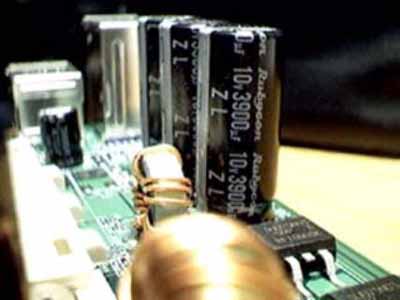
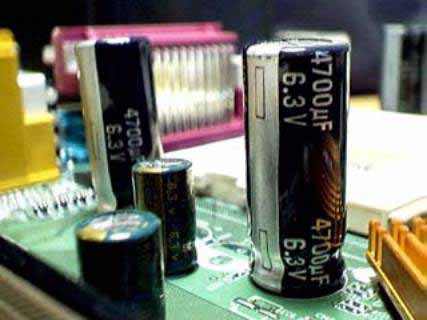
Since the K7T Pro2 does not include many extra features, Microstar was able to use a smaller PCB of about 12 by 8 inches. This helps to lower the cost of the motherboard, so users can buy the board at a lower price. One thing to notice is the placement of the power supply connector. For most KT133 motherboards the connectors are next to the serial / parallel ports, so the power cables will have to run over the memory and the CPU, and thus blocking airflow. On the K7T Pro2, the connector is placed below the CPU socket and next to the DIMM slots. The good news is the power cables will not have to run over the CPU, so it does not block airflow. On the other hand, since the connector is so close to the DIMM slots, there might be problems connecting and disconnecting the power supply. Although so far the best place for power supply connectors is probably the right edge of the board, what Microstar did for K7T Pro2 is already a big improvement for CPU cooling.
The VIA 8363 North Bridge is the core of the KT133 chipset. It provides all the major features of the KT133, including the 133Mhz memory bus and AGP 4X support. The AGP Slot is a “universal slot,” which means it is not keyed specifically for AGP 2X or AGP 4X cards, so the user can install almost any current AGP card in the slot. New to Microstar boards is the AGP retention mechanism to help locking the AGP video card in place.
There are three DIMM slots on the K7T Pro2, allowing a maximum of 1.5GB SDRAM. The 8363 memory controller in K7T Pro2 allows you to run your memory at either 133MHz or 100MHz. Therefore, users with PC133 SDRAM can take advantage of the increased bandwidth over PC100 SDRAM, going from 800MB/s to 1.06GB/s. This can be done easily in the BIOS by choosing either HCLK +33MHz or default (which will be 100MHz). There is also a setting for CAS latency in the BIOS, so users can push their memory to the limit if they have some good memory.
The K7T Pro2 is still using the VIA 686A as their South Bridge, which supports dual channel Ultra ATA 66 (2 devices per channel) and 2 USB root hubs (4 USB ports total). Two traditional USB ports are mounted at the back of the motherboard together with the serial / parallel ports, and there are connectors ready for USB 3 and 4 at the bottom left hand side of the board. Unfortunately, Microstar does not include the necessary expansion bracket to take advantage of those extra USB ports.
Although KT133 motherboards using the VIA 686B South Bridge, with its Ultra ATA 100 support, have started to arrive, Microstar chose not to include it on the K7T Pro2. Microstar has also chosen not to supply the MS-6915 Ultra ATA 100 that was optionally included with the K7T Pro. This may be because they are working on incorporating the VIA 686B South Bridge with the K7T Pro2, eliminating the need for a separate Ultra ATA 100 controller.
The 6/1/1/0 (PCI/AGP/CNR/ISA) expansion slot configuration on K7T Pro2 should be more than enough for most users. Just like the K7T Pro, the CNR slot Microstar puts in is an odd choice considering the VIA686A South Bridge does not include integrated network support. Although the 686A includes an integrated PCI-ISA bridge, Microstar decided not to include the ISA slot and put in one more PCI slot to make it a total of six. For users with old ISA devices like modem or SCSI controller, Microstar also provides another version of K7T Pro2, which features five PCI slots and one ISA slot. The VIA 686A only supports five bus mastering PCI slots, but Microstar has included their own PCI arbiter chip to all 6 slots to support bus mastering devices.
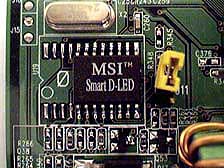 The
K7T Pro2 also features the Smart D-LED technology by Microstar. In case you’re
not faimilar with the D-LED technology, it is basically a set of 4 LEDs mounted
between the serial / parallel ports and the game / sound ports, facing the inside
of the computer. As the system boots, the LEDs blink green and red as different
components are initialized. If everything is successful, all LEDs will finally
turn green. If problems occur, you can use the error code shown by the LED’s
to help identify the problem.
The
K7T Pro2 also features the Smart D-LED technology by Microstar. In case you’re
not faimilar with the D-LED technology, it is basically a set of 4 LEDs mounted
between the serial / parallel ports and the game / sound ports, facing the inside
of the computer. As the system boots, the LEDs blink green and red as different
components are initialized. If everything is successful, all LEDs will finally
turn green. If problems occur, you can use the error code shown by the LED’s
to help identify the problem.
With Smart D-LED technology, when an error occurs during initialization, the speaker sitting right next to the BIOS will tell you what is wrong in plain English or Chinese. Unfortunately, in our sample, neither languages would work, but we were able to hear some noise coming out of the speaker when no memory is installed.
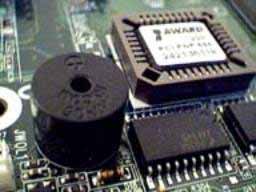
Like the K7T Pro and K7T Master, the K7T Pro2 uses the VIA VT1611A AC97 CODEC to provide some basic sound card features, although for users who care about their 3D PC sound would definitely want a hardware-based PCI sound card for higher quality sound effects.
Bundled with the K7T Pro2 is the new Fuzzy Logic III software. It is mainly a revised version of the Fuzzy Logic II with some bug fixes. This software is Windows based and is currently available for Windows 95/98/Me only. Inside the Fuzzy Logic III, users can read about the information of their CPUs, temperatures, speed of the fan, PCI bus speed, etc… But the most useful feature of this software is increasing or decreasing the FSB of the motherboard, all from within Windows. There are two modes of operation. If users select the auto setting, the software will automatically overclock the CPU, by increasing the FSB one step at a time until the CPU becomes unstable, and then backing off a bit. Users can also use the manual mode where they can input any desire FSB of their choice. Although most of us still prefer to work with the BIOS directly, this definitely provides another media for users who do not feel very comfortable with the BIOS. However, since this software only supports Windows 9x, users of other operating systems will not be able to benefit from it.
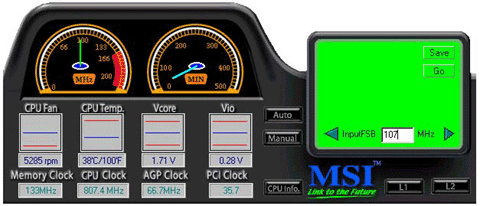
Another nice feature from Microstar is the Live BIOS. With the releases of Windows 2000 and Windows Millennium Edition, Microsoft has phased out a true DOS mode, which is essential for traditional BIOS upgrades. Therefore, Microstar includes their Live BIOS software, which connects to the Internet, downloads the latest BIOS, and performs the flash upgrades - all within Windows. Again this is not useful for non-Windows users, but it is a very good start for next generation operating systems.
The manual Microstar includes with the K7T Pro2 contains detailed information on all the jumpers and settings. However, there are only a few instructions on how to install the motherboard, which is essential for new users. Microstar also includes very detailed information on all the BIOS settings, so users can tweak the BIOS accordingly. There are also instructions on how to install the VIA drivers and the AC’97 CODEC. All the software, including Fuzzy Logic III, Live BIOS, and drivers are in the CD Microstar ships with the motherboard.
The Bad
The DIMM slots are very close to the AGP slot, especially since Microstar puts now includes an AGP retention mechanism. This means that you have to install the memory before the video card, otherwise the video card will block the clips of the DIMM slots.
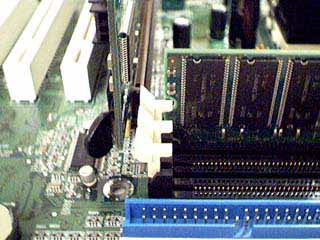
Microstar will not ship any Ultra ATA 100 controller with the K7T Pro2. Although at this point no hard drive has a sustained transfer rate of higher than 40MB/sec, that will not be the case for long. Hopefully Microstar will incorporate the 686B South Bridge soon, which adds Ultra ATA 100 support.
Moreover, Microstar does not ship the bracket required to take advantage of USB ports 3 and 4, provided by the 686A South Bridge.
D-LED is a very good feature that would be even better if they could be viewed from outside of the case, perhaps through the I/O shield. Moreover, the Smart D-LED did not function properly in our evaluation sample, so we cannot judge how useful this feature is.
The manual is fair, but if Microstar put in more information about the installation of the motherboard, it would be much more helpful to new users.
USB Compatibility
· Number of Front Universal Serial Bus Root Ports: 2
· Number of Rear Universal Serial Bus Root Ports: 2
· USB IRQ Enable/Disable in BIOS: Yes
· USB Keyboard Support in BIOS: Yes
Recommended SDRAM
Recommended SDRAM: 1 x 128MB Corsair PC133 SDRAM; 1 x 128MB Mushkin PC133 SDRAM
SDRAM Tested: 1 x 128MB Mushkin PC133 SDRAM
Manufacturer: Corsair
Purchase Website: http://www.corsairmicro.com
Manufacturer: Mushkin
Purchase Website: http://www.mushkin.com
The Test
In recent times, choosing a motherboard cannot be completely determined by a Winstone score. Now, many boards come within one Winstone point of each other and therefore the need to benchmark boards against each other falls. Therefore you should not base your decision entirely on the benchmarks you see here, but also on the technical features and advantages of this particular board, seeing as that will probably make the greatest difference in your overall experience.
Click Here to learn about AnandTech's Motherboard Testing Methodology.
|
Test Configuration |
|
| Processor(s): |
AMD
Athlon (Thunderbird) 800MHz
|
| RAM: |
1 x 128MB Mushkin PC133 SDRAM
|
| Hard Drive(s): |
Western Digital 153BA Ultra
ATA 66 7200 RPM
|
| Bus Master Drivers: |
VIA 4-in-1 v4.24 Service
Pack
|
| Video Card(s): |
NVIDIA
GeForce 2 GTS 32MB DDR
|
| Video Drivers: |
NVIDIA
Detonator 5.22
|
| Operation System(s): |
Windows
98 SE
|
| Motherboard Revision: |
Microstar
K7T Pro2 Revision 1.0
|
|
Windows 98 Performance |
|||
|
Athlon
800 (KT133)
|
Sysmark
2000
|
Content
Creation
Winstone 2000 |
Quake
III Arena - 640 x 480 x 16
|
| Microstar K7T Pro2 |
162
|
32.5
|
122.5
|
| Microstar K7T Pro1 |
161
|
32.0
|
121.6
|
| Chaintech CT-7AIV2 |
162
|
31.4
|
71.1*
|
| Iwill KV200-R |
160
|
32.9
|
123.9
|
| Microstar K7T Master |
161
|
32.7
|
123.7
|
| Soyo SY-K7VTA |
160
|
27.5
|
127.0
|
*Note: Since the CT-7AIV2 does not have an AGP slot, we are forced to use the on-board video, which resulted in extremely poor performance in Quake III Arena. The SYSMark 2000 and Content Creation Winstone 2000 results are best for comparison purposes.
Final Words
You have to believe that Microstar is catching up to ABIT and ASUS. They prove that again by releasing the K7T Pro2, which is the third KT133 motherboard we have reviewed so far featuring the multiplier settings. It is clear that more and more motherboards with this tweaking feature will start to show up.
The K7T Pro2 is an extremely stable KT133 motherboard, and it has the ability to push AMD CPUs to the limits. There is no doubt that hardware enthusiasts will be pleased with this motherboard. With the expensive price tags hanging on the ABIT and ASUS KT133 solutions, for people who want a Socket-A motherboard with multiplier control, but not necessarily ATA100 RAID, they should be looking for out when the Microstar K7T Pro2 hits the streets.
How it Rates
|
AnandTech Motherboard Rating |
|
|
Rating
(x/10)
|
|
|
Performance
|
5.0
|
|
Price
|
6.5
|
|
Stability
|
9.0
|
|
Quality
|
8.5
|
|
Features
|
8.0
|
|
Layout
|
6.5
|
|
Availability
|
6.0
|
|
Documentation & Software Bundle
|
5.5
|
| Overall Rating - not an average Click here to find out why |
8.0
|

